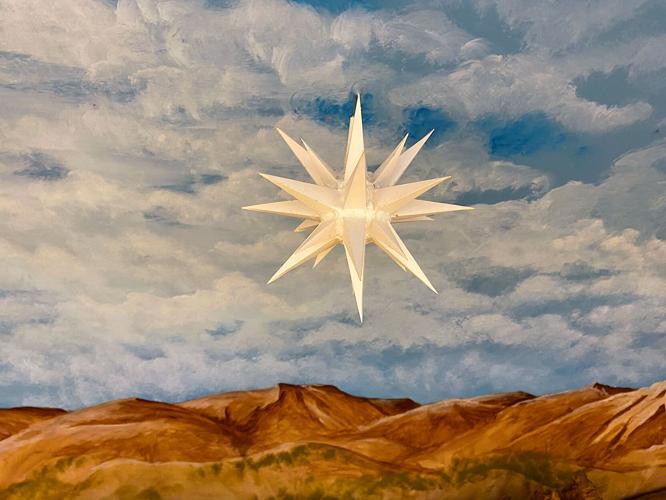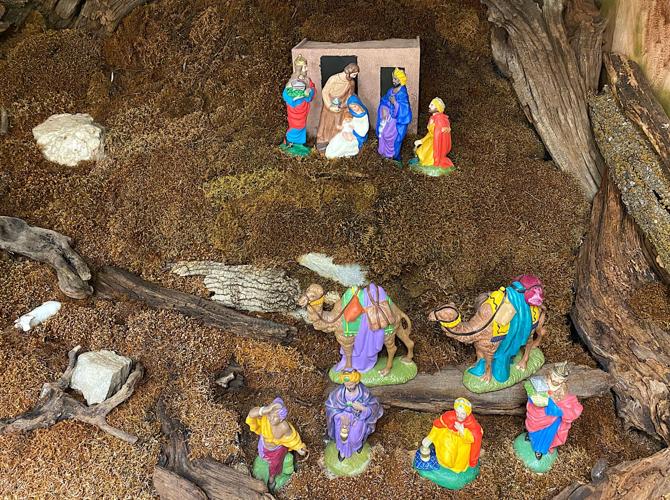The Lititz Moravian Church will present its traditional putz this holiday season.
As Brenda Barnes of the Moravian Church notes, putz rhymes with “foots” and means “to decorate” – not to be confused with the Yiddish word for a fool, which is pronounced differently.
This type of putz might best be described as a Nativity scene on a grander scale, yet in miniature form.
But it doesn’t just show the Nativity with Mary, Joseph and the baby Jesus in a manger. It shows the big picture, from the Prophet Isaiah with his Old Testament prophecy to the visit to the Holy Family from the Wise Men.
The putz is housed in the lower level of the Moravian Church offices in Lititz. It has been on display since the mid-1900s. The original diorama was crafted sometime around the 1950s or ’60s, and has been improved and updated since. Its current form is much like it was in the late 1970s, with its natural bark and moss covering.
Vignettes show the Bible story of the birth of Christ, following the progression from the Old Testament and the prophecy of Isaiah to the annunciation to Mary by the angel. There are shepherds in the fields tending their sheep, a quiet cave outside of Bethlehem where Mary and Joseph seek refuge to have their child, a heavenly host of angels, the star of Bethlehem and the wise men traveling to bestow gifts to Jesus.
The city of Jerusalem is shown on a grand scale, while Bethlehem is but a tiny village. Figures are nestled in the soft moss. The cloud-tossed sky is painted in shades of blue, framed by the towering mountains of the Judean countryside.
More Faith and Values Content:
- Lancaster Jewish community approach Hanukkah with 'different sense' this season
- 3 local churches plan Blue Christmas services to help those grieving at the holidays
Perhaps the most impressive aspect of the putz is the stunning cloud-tossed sky with soft blues and creamy white. That sky was painted by Lititz artist Sandy Roland and provides the perfect backdrop to the Moravian star that represents the Star of Bethlehem.
Historically, the tradition of the putz being displayed at Lititz Moravian Church didn’t begin until the 20th century. Before that, Lititz Moravians displayed a putz in their homes and not at the church.
The concept of the putz is believed to have dated back to the 13th century and St. Francis of Assisi, who told the story of the nativity through carvings. In colonial America, the Moravian church members carried on the earlier tradition with displays in their homes.
It was something of a competition among neighbors, who wanted to have the best putz in the neighborhood.
In the early days of the Moravian Church in America, in towns like Bethlehem and Lititz, church members would go “putzing,” to see the putzes in other homes. Families would prepare and decorate their own putz, then visit the neighbors to see what they had done.
Today’s putz at the Lititz Moravian Church has advanced significantly. It is a finely tuned electronic production with lights, music and a voiceover recording that tells the story of Christmas. That voice was recorded by Barry Frey of the Moravian Trombone Choir. The songs were recorded in the Moravian Church by the choir and the children’s choir accompanied by the grand 1793 Tannenbaum organ.
The presentation of the putz takes about 20 minutes and includes musical selections like “Silent Night.” “What Child is This,” “Come All Ye Faithful” and other hymns — including some lesser-known Moravian hymns — to tell the story through music.
“Children have been known to sit spellbound,” Barnes says.
It can also bring on a few tears, as viewers realize the significance of the story of Christmas.
The putz can be viewed every Saturday in December from noon to 2 p.m., with no appointment needed. To make an appointment for groups to see the putz, call the church office at 717-626-8515 during office hours. The putz can also be viewed from Dec. 26 to 30 at 7 p.m. and after the Dec. 31 Watchnight Service.






